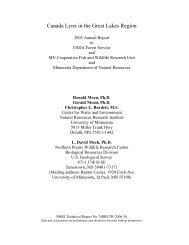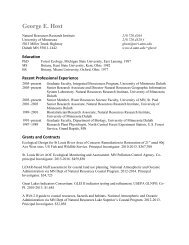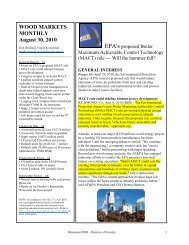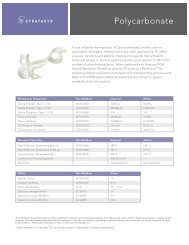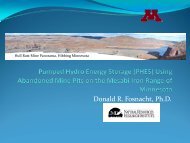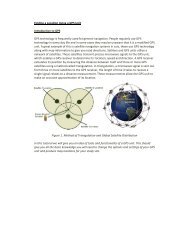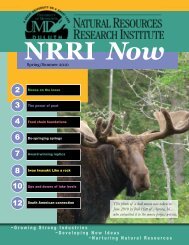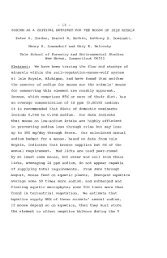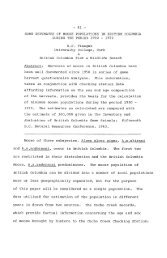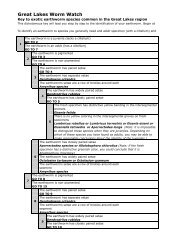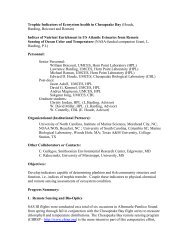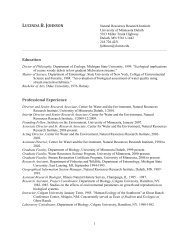276 Tulbure et al.FIG. 3. PCR/RFLP analysis <strong>of</strong> non-nativePhragmites population from Point au Sauble wetland.Lanes 1 and 2 contain the rbc primer withthe HhaI digested DNA and undigested DNA,respectively. Lanes 3 and 4 contain the trn primerwith the RsaI digested DNA and undigested DNA,respectively. Lane 5 contains a 100 bp ladder(Promega, Madison, WI). The rbc productdigested and the trn product did not, indicatingthe source DNA was from the invasive genotype.perennials. The decreased cover <strong>of</strong> Schoenoplectustabernaemontani and Sagittaria latifolia was presumablydue to shading <strong>by</strong> taller successionalplants.Prior authors have identified the dynamic nature<strong>of</strong> Point au Sauble and other Green Bay wetlands inresponse to such water level fluctuations (Epstein etal. 2002, UWGB 2004). The difference between ourobserved changes at Point au Sauble and previousreports, which point out the dominance <strong>of</strong> Typhaspp. as the water level increases (UWGB 2004), isthe dominance <strong>of</strong> Phragmites. The fact that Phragmitesexpanded so rapidly in only 3 years is a cause<strong>of</strong> concern. Moreover, Phragmites from Point auSauble was found to belong to the more aggressive,introduced genotype. Therefore it may disrupt thenatural cycles <strong>of</strong> vegetation replacement that occurunder native plant communities in healthy coastalwetlands.Although there was an increase in species richnessbetween 2001 and 2004, we believe that this istransient based on our data collected at this site. Weexpect to see a decrease in species richness in plotswith the continued expansion and densification <strong>of</strong>Phragmites, similar to what we have seen at thefour plots where Phragmites had a 100% cover.Phragmites is an invasive taxon (sensu Richardsonet al. 2000) that is a clonal dominant (sensuBoutin and Keddy 1993). Under the predictions <strong>of</strong>the hump-backed model (Grime 2000, Moore andKeddy 1989), the large standing crop <strong>of</strong> this clonaldominant species would be expected to reducespecies richness because the greatest species richnessis usually reached at moderate standing crops.Phragmites forms monospecific stands with a consequentreduction in species diversity (Marks et al.1994). Such a reduction did occur in the four plotswhere Phragmites had a 100% cover in 2004,species richness being significantly lower in thesefour plots than in the plots where Phragmites wasnot present or had a low cover.“Mean coverage <strong>by</strong> invasive species” was an indicatorthat suggested a degradation <strong>of</strong> the lagoon.Species richness and other metrics commonly usedas wetland indicators (i.e., FQI and mean coefficient<strong>of</strong> conservatism) did not point out a degradation<strong>of</strong> this wetland. However, greater values <strong>of</strong> allthese three metrics are expected as the site evolvedfrom a newly established community dominated <strong>by</strong>annuals to a more mature community dominated <strong>by</strong>perennials. The greater height <strong>of</strong> the dominantherbaceous plants in 2004 can be explained <strong>by</strong> thedominance <strong>of</strong> Phragmites or Typha in almost all <strong>of</strong>the plots. These are invasive species in the U.S. andgrow taller than native species (Galatowitsch et al.1999). Plant size larger than that <strong>of</strong> associatespecies is a key trait that allows plant species todominate, such that tall stature is a characteristic <strong>of</strong>competitive species (Grime 1973, Grime 2000).Monoculture is achieved <strong>by</strong> larger species throughtheir ability to compete for light (tall shoots), forwater and nutrients (high below ground biomass),and through the presence <strong>of</strong> a high density <strong>of</strong> herbaceouslitter throughout the year (Grime 2000). BothTypha and Phragmites form mono-dominant stands,and both are well adapted to sustained inundation(Haslam 1971, Shay and Shay 1986). These fea-
Phragmites australis <strong>Invasion</strong> 277tures promote Phragmites as a good competitor inthe stands where it occurs (Haslam 1971).While predicting invasion <strong>of</strong> a community is difficultbecause there is no unique theory to successfullyexplain plant invasions (Williamson 1999,Grime 2000, Zedler and Kercher 2004), fluctuation<strong>of</strong> resource availability may be one <strong>of</strong> the key factorsthat control invasibility (Davis et al. 2000).New substrate availability makes an area susceptibleto invasion (Grime 2000) and is one <strong>of</strong> the factorsthat make riparian areas more prone to invasion(Tickner et al. 2001).Establishment <strong>of</strong> Phragmites typically occurs onbare, unvegetated moist soils after water levels recede(Chambers et al. 1999, Galatowitsch et al.1999, Ailstock et al. 2001, Pengra et al. 2007). Thisspecies typically invades starting from the uplandfringe <strong>of</strong> the wetland via stolons and rhizomes. Alternatively,it may start on a high point within thewetland, such as a dike remnant, and then spreadinto the wetland plain. Unlike rhizomes, stolons arelocated aboveground and usually elongate morerapidly than rhizomes. Phragmites propagation <strong>by</strong>seeds is limited (Haslam 1970, 1971). Vegetativepropagation is efficient through rhizome portionstransported <strong>by</strong> water, man, or stolons from near<strong>by</strong>colonies (Haslam 1971). We observed long Phragmitesstolons on beach areas north <strong>of</strong> the lagoon,and believe that stolon growth was the primarymechanism <strong>of</strong> Phragmites expansion within the lagoon.The rapid invasion <strong>of</strong> Point au Sauble <strong>by</strong> Phragmitescannot and should not be considered representative<strong>of</strong> all <strong>Great</strong> <strong>Lakes</strong> coastal wetlands.Although the extremely low water levels between1999 and early 2004 occurred throughout lakesMichigan and Huron, Phragmites stands observedelsewhere in Green Bay <strong>by</strong> co-author Tulbure as a2004 field assistant to Pengra (2005) were muchless extensive than those found at Point au Sable. Inthat study, Pengra and co-workers visited 82 GreenBay wetland locations with emergent vegetationand found that 34 <strong>of</strong> them had Phragmites presentin 2004. We believe that this could be because theAu Sauble wetland is a lagoon protected in the interior<strong>of</strong> a hook-shaped peninsula, whereas other sitesare sandy peninsulas and associated embaymentsthat are more open to wave action (e.g., Little TailPoint, and Long Tail Point, Wisconsin DNR 2006).Also, other sites had organic substrates (e.g., SensibaWildlife Area) rather than silty substrate asPoint au Sauble, which might have been less proneto Phragmites invasion. We believe that the exposure<strong>of</strong> unvegetated silty mineral soils at Point auSauble, which suggests the presence <strong>of</strong> a depositionalenvironment, created conditions conducive toPhragmites colonization and may be atypical forthe region. Based on these results, we predict thatsites with exposed mineral soils are most susceptibleto Phragmites invasion, and future studiesshould further test this hypothesis.The GLEI project was designed to be conductedas single-sampling event, not an analysis <strong>of</strong> changeover time. However, these results illustrate the benefits<strong>of</strong> the sampling and documentation protocolestablished <strong>by</strong> GLEI. Without the careful recordskept <strong>by</strong> the GLEI sampling crew in 2001, documentation<strong>of</strong> this rapid Phragmites expansion would nothave been possible.ACKNOWLEDGMENTSWe thank Dr. Elizabeth Lynch and an anonymousreviewer for helpful comments on an earlier draft.This research has been supported <strong>by</strong> a grant fromthe U.S. EPA’s Science to Achieve Results Estuarineand <strong>Great</strong> <strong>Lakes</strong> program through funding to the<strong>Great</strong> <strong>Lakes</strong> Environmental Indicators project, U.S.EPA Agreement EPA/R-828675. Although the researchdescribed in this article has been fundedwholly <strong>by</strong> the U.S. EPA, it has not been subjectedto the agency’s required peer and policy review andtherefore does not necessarily reflect the views <strong>of</strong>the agency and no <strong>of</strong>ficial endorsement should beinferred.REFERENCESAilstock, M.S., Norman, C.M., and Bushmann. P.J.2001. Common Reed, Phragmites australis: controland effects upon biodiversity in freshwater nontidalwetlands. Resour. Ecol. 9(1):49–59.ASTM (American Society for Testing and Materials).1997. ASTM E 1923, Standard Guide forSampling Terrestrial and <strong>Wetland</strong>s Vegetation. ASTMInternational, West Conshohocken, PA, USA.Bart, D., and Hartman, J.M. 2000. Environmental determinants<strong>of</strong> Phragmites australis expansion in a NewJersey salt marsh: an experimental approach. Oikos89:59–69.———, and Hartman, J.M. 2003. The role <strong>of</strong> large rhizomedispersals and low salinity windows in theestablishment <strong>of</strong> common reed, Phragmites australis,in salt marshes: new links to human activities. Estuaries26(2B):436–443.Bernthal, T.W. 2003. Development <strong>of</strong> a floristic qualityassessment methodology for Wisconsin. Final reportto the U.S. Environmental Protection Agency. Region



